An Overview of Modelling and Energy Management Strategies for Hybrid Electric Vehicles
Abstract
1. Introduction
2. Types and Characteristics of the Powertrains for HEVs
2.1. Series Hybrid Electric Vehicle
2.2. Parallel Hybrid Electric Vehicle
2.3. Series–Parallel Hybrid Electric Vehicle
3. Research and Current Status of Energy Management Strategies for HEVs
3.1. Rule-Based Energy Management Strategies
3.1.1. Deterministic Rule-Based Energy Management Strategies
3.1.2. Fuzzy Rule-Based Energy Management Strategies
3.2. Optimization-Based Energy Management Strategies
3.2.1. Equivalent Consumption Minimization Strategies
3.2.2. Pontryagin’s Minimum Principle
3.2.3. Model Predictive Control Strategy
3.2.4. Dynamic Programming
3.3. Learning Based Energy Management Strategies
4. Future Challenges
4.1. Multi-Source Information Acquisition and Processing
4.2. Power Demand Forecasting for Different Airspace
4.3. Vehicle Control Capability and Constraints
5. Conclusions
Funding
Institutional Review Board Statement
Informed Consent Statement
Data Availability Statement
Conflicts of Interest
References
- Amjad, S.; Neelakrishnan, S.; Rudramoorthy, R. Review of design considerations and technological challenges for successful development and deployment of plug-in hybrid electric vehicles. Renew. Sustain. Energy Rev. 2010, 14, 1104–1110. [Google Scholar] [CrossRef]
- Emadi, A.; Rajashekara, K.; Williamson, S.; Lukic, S. Topological Overview of Hybrid Electric and Fuel Cell Vehicular Power System Architectures and Configurations. IEEE Trans. Veh. Technol. 2005, 54, 763–770. [Google Scholar] [CrossRef]
- Delprat, S.; Lauber, J.; Guerra, T.; Rimaux, J. Control of a Parallel Hybrid Powertrain: Optimal Control. IEEE Trans. Veh. Technol. 2004, 53, 872–881. [Google Scholar] [CrossRef]
- Cai, Y.; Yang, F.; Ouyang, M. Impact of control strategy on battery degradation for a plug-in hybrid electric city bus in China. Energy 2016, 116, 1020–1030. [Google Scholar] [CrossRef]
- Raykin, L.; Roorda, M.J.; MacLean, H.L. Impacts of driving patterns on tank-to-wheel energy use of plug-in hybrid electric vehicles. Transp. Res. Part D Transp. Environ. 2012, 17, 243–250. [Google Scholar] [CrossRef]
- Jeong, K.S.; Oh, B.S. Fuel economy and life-cycle cost analysis of a fuel cell hybrid vehicle. J. Power Sources 2002, 105, 58–65. [Google Scholar] [CrossRef]
- Nanaki, E.A.; Koroneos, C.J. Comparative economic and environmental analysis of conventional, hybrid and electric vehicles—The case study of Greece. J. Clean. Prod. 2013, 53, 261–266. [Google Scholar] [CrossRef]
- Kantor, I.; Fowler, M.W.; Hajimiragha, A.; Elkamel, A. Air quality and environmental impacts of alternative vehicle technologies in Ontario, Canada. Int. J. Hydrogen Energy 2010, 35, 5145–5153. [Google Scholar] [CrossRef]
- Gao, W. Performance Comparison of a Fuel Cell-Battery Hybrid Powertrain and a Fuel Cell-Ultracapacitor Hybrid Powertrain. IEEE Trans. Veh. Technol. 2005, 54, 846–855. [Google Scholar] [CrossRef]
- Ragheb, H.; Aydin, M.; El-Gindy, M.; Kishawy, H. Comparison of gradability performance of fuel cell hybrid electric and internal-combustion engine vehicles. J. Power Sources 2013, 221, 447–454. [Google Scholar] [CrossRef]
- Li, Z.; Khajepour, A.; Song, J. A comprehensive review of the key technologies for pure electric vehicles. Energy 2019, 182, 824–839. [Google Scholar] [CrossRef]
- Delucchi, M.A.; Yang, C.; Burke, A.F.; Ogden, J.M.; Kurani, K.; Kessler, J.; Sperling, D. An assessment of electric vehicles: Technology, infrastructure requirements, greenhouse-gas emissions, petroleum use, material use, lifetime cost, consumer acceptance and policy initiatives. Philos. Trans. R. Soc. A 2014, 372, 20120325. [Google Scholar] [CrossRef] [PubMed]
- Wada, M. Research and development of electric vehicles for clean transportation. J. Environ. Sci. 2009, 21, 745–749. [Google Scholar] [CrossRef]
- Noori, M.; Tatari, O. Development of an agent-based model for regional market penetration projections of electric vehicles in the United States. Energy 2016, 96, 215–230. [Google Scholar] [CrossRef]
- Zahabi, S.A.H.; Miranda-Moreno, L.; Barla, P.; Vincent, B. Fuel economy of hybrid-electric versus conventional gasoline vehicles in real-world conditions: A case study of cold cities in Quebec, Canada. Transp. Res. Part D Transp. Environ. 2014, 32, 184–192. [Google Scholar] [CrossRef]
- Zhao, J.; Xi, X.; Na, Q.; Wang, S.; Kadry, S.N.; Kumar, P.M. The technological innovation of hybrid and plug-in electric vehicles for environment carbon pollution control. Environ. Impact Assess. Rev. 2021, 86, 106506. [Google Scholar] [CrossRef]
- Ehsani, M.; Gao, Y.; Miller, J.M. Hybrid Electric Vehicles: Architecture and Motor Drives. Proc. IEEE 2007, 95, 719–728. [Google Scholar] [CrossRef]
- Sun, X.; Shi, Z.; Zhu, J. Multiobjective Design Optimization of an IPMSM for EVs Based on Fuzzy Method and Sequential Taguchi Method. IEEE Trans. Ind. Electron. 2021, 68, 10592–10600. [Google Scholar] [CrossRef]
- Jin, Z.; Sun, X.; Chen, L.; Yang, Z. Robust multi-objective optimization of a 3-pole active magnetic bearing based on combined curves with climbing algorithm. IEEE Trans. Ind. Electron. 2021, 69, 5491–5501. [Google Scholar] [CrossRef]
- Wang, Y.; Wang, J.; Hao, C.; Wang, X.; Li, Q.; Zhai, J.; Ge, Y.; Hao, L.; Tan, J. Characteristics of instantaneous particle number (PN) emissions from hybrid electric vehicles under the real-world driving conditions. Fuel 2021, 286, 119466. [Google Scholar] [CrossRef]
- PPlötz, P.; Moll, C.; Bieker, G.; Mock, P. From lab-to-road: Real-world fuel consumption and CO2 emissions of plug-in hybrid electric vehicles. Environ. Res. Lett. 2021, 16, 054078. [Google Scholar] [CrossRef]
- Suhail, M.; Akhtar, I.; Kirmani, S.; Jameel, M. Development of Progressive Fuzzy Logic and ANFIS Control for Energy Management of Plug-In Hybrid Electric Vehicle. IEEE Access 2021, 9, 62219–62231. [Google Scholar] [CrossRef]
- Paladini, V.; Donateo, T.; de Risi, A.; Laforgia, D. Super-capacitors fuel-cell hybrid electric vehicle optimization and control strategy development. Energy Convers. Manag. 2007, 48, 3001–3008. [Google Scholar] [CrossRef]
- Salazar, M.; Elbert, P.; Ebbesen, S.; Bussi, C.; Onder, C.H. Time-optimal Control Policy for a Hybrid Electric Race Car. IEEE Trans. Control Syst. Technol. 2017, 25, 1921–1934. [Google Scholar] [CrossRef]
- Ducusin, M.; Gargies, S.; Berhanu, B.; Mi, C. Modeling of a Series Hybrid Electric High-Mobility Multipurpose Wheeled Vehicle. IEEE Trans. Veh. Technol. 2007, 56, 557–565. [Google Scholar] [CrossRef]
- Vinot, E.; Trigui, R.; Cheng, Y.; Espanet, C.; Bouscayrol, A.; Reinbold, V. Improvement of an EVT-Based HEV Using Dynamic Programming. IEEE Trans. Veh. Technol. 2014, 63, 40–50. [Google Scholar] [CrossRef]
- Qin, F.; Xu, G.; Hu, Y.; Xu, K.; Li, W. Stochastic Optimal Control of Parallel Hybrid Electric Vehicles. Energies 2017, 10, 214. [Google Scholar] [CrossRef]
- Fajri, P.; Ferdowsi, M.; Lotfi, N.; Landers, R. Development of an Educational Small-Scale Hybrid Electric Vehicle (HEV) Setup. IEEE Intell. Transp. Syst. Mag. 2016, 8, 8–21. [Google Scholar] [CrossRef]
- Luo, C.; Shen, Z.; Evangelou, S.; Xiong, G.; Wang, F.-Y. The combination of two control strategies for series hybrid electric vehicles. IEEE/CAA J. Autom. Sin. 2019, 6, 596–608. [Google Scholar] [CrossRef]
- Zhang, L.; Qi, B.; Zhang, R.; Liu, J.; Wang, L. Powertrain design and energy management of a novel coaxial series-parallel plug-in hybrid electric vehicle. Sci. China Technol. Sci. 2016, 59, 618–630. [Google Scholar] [CrossRef]
- Sun, X.; Cao, J.; Lei, G.; Guo, Y.; Zhu, J. A Robust Deadbeat Predictive Controller with Delay Compensation Based on Composite Sliding-Mode Observer for PMSMs. IEEE Trans. Power Electron. 2021, 36, 10742–10752. [Google Scholar] [CrossRef]
- Gao, Y.; Ehsani, M. Parametric design of the traction motor and energy storage for series hybrid off-road and military vehicles. IEEE Trans. Power Electron. 2006, 21, 749–755. [Google Scholar]
- Harmon, F.G.; Frank, A.A.; Joshi, S.S. The control of a parallel hybrid-electric propulsion system for a small unmanned aerial vehicle using a CMAC neural network. Neural Netw. 2005, 18, 772–780. [Google Scholar] [CrossRef]
- Nguyễn, B.-H.; Trovão, J.P.F.; German, R.; Bouscayrol, A. Real-Time Energy Management of Parallel Hybrid Electric Vehicles Using Linear Quadratic Regulation. Energies 2020, 13, 5538. [Google Scholar] [CrossRef]
- Lukic, S.M.; Emadi, A. Effects of Drivetrain Hybridization on Fuel Economy and Dynamic Performance of Parallel Hybrid Electric Vehicles. IEEE Trans. Veh. Technol. 2004, 53, 385–389. [Google Scholar] [CrossRef]
- Al-Samari, A. Study of emissions and fuel economy for parallel hybrid versus conventional vehicles on real world and standard driving cycles. Alex. Eng. J. 2017, 56, 721–726. [Google Scholar] [CrossRef]
- Wei, C.; Sun, X.; Chen, Y.; Zang, L.; Bai, S. Comparison of architecture and adaptive energy management strategy for plug-in hybrid electric logistics vehicle. Energy 2021, 230, 120858. [Google Scholar] [CrossRef]
- Shi, Z.; Sun, X.; Lei, G.; Yang, Z.; Guo, Y.; Zhu, J. Analysis and Optimization of Radial Force of Permanent-Magnet Synchronous Hub Motors. IEEE Trans. Magn. 2020, 56, 1–4. [Google Scholar] [CrossRef]
- Nino-Baron, C.E.; Tariq, A.R.; Zhu, G.; Strangas, E.G. Trajectory Optimization for the Engine–Generator Operation of a Series Hybrid Electric Vehicle. IEEE Trans. Veh. Technol. 2011, 60, 2438–2447. [Google Scholar] [CrossRef]
- Corno, M.; Roselli, F.; Savaresi, S.M. Bilateral Control of SeNZA—A Series Hybrid Electric Bicycle. IEEE Trans. Control Syst. Technol. 2017, 25, 864–874. [Google Scholar] [CrossRef]
- Liu, H.; Zhao, J.; Qing, T.; Li, X.; Wang, Z. Energy consumption analysis of a parallel PHEV with different configurations based on a typical driving cycle. Energy Rep. 2021, 7, 254–265. [Google Scholar] [CrossRef]
- Hu, D.; Zhang, J.; Hu, L.; Li, J.; Yang, Q. Dynamic characteristic analysis for clutch engagement process of series–parallel hybrid electric vehicle. Nonlinear Dyn. 2021, 105, 45–59. [Google Scholar] [CrossRef]
- Chen, Z.; Guo, N.; Shen, J.; Xiao, R.; Dong, P. A Hierarchical Energy Management Strategy for Power-Split Plug-in Hybrid Electric Vehicles Considering Velocity Prediction. IEEE Access 2018, 6, 33261–33274. [Google Scholar] [CrossRef]
- Sun, X.; Cao, J.; Lei, G.; Guo, Y.; Zhu, J. A Composite Sliding Mode Control for SPMSM Drives Based on a New Hybrid Reaching Law with Disturbance Compensation. IEEE Trans. Transp. Electrif. 2021, 7, 1427–1436. [Google Scholar] [CrossRef]
- Liu, C.-Z.; Li, L.; Yong, J.-W.; Muhammad, F.; Cheng, S.; Wang, X.-Y.; Li, W.-B. The Bionics and its Application in Energy Management Strategy of Plug-in Hybrid Electric Vehicle Formation. IEEE Trans. Intell. Transp. Syst. 2021, 22, 7860–7874. [Google Scholar] [CrossRef]
- Wirasingha, S.G.; Emadi, A. Classification and Review of Control Strategies for Plug-In Hybrid Electric Vehicles. IEEE Trans. Veh. Technol. 2011, 60, 111–122. [Google Scholar] [CrossRef]
- Martinez, J.S.; Hissel, D.; Pera, M.-C.; Amiet, M. Practical Control Structure and Energy Management of a Testbed Hybrid Electric Vehicle. IEEE Trans. Veh. Technol. 2011, 60, 4139–4152. [Google Scholar] [CrossRef]
- Xu, S.; Li, S.E.; Peng, H.; Cheng, B.; Zhang, X.; Pan, Z. Fuel-Saving Cruising Strategies for Parallel HEVs. IEEE Trans. Veh. Technol. 2016, 65, 4676–4686. [Google Scholar] [CrossRef]
- Zou, Y.; Kong, Z.; Liu, T.; Liu, D. A Real-Time Markov Chain Driver Model for Tracked Vehicles and its Validation: Its Adaptability via Stochastic Dynamic Programming. IEEE Trans. Veh. Technol. 2016, 66, 3571–3582. [Google Scholar] [CrossRef]
- Di Cairano, S.; Bernardini, D.; Bemporad, A.; Kolmanovsky, I.V. Stochastic MPC with Learning for Driver-Predictive Vehicle Control and its Application to HEV Energy Management. IEEE Trans. Control Syst. Technol. 2014, 22, 1018–1031. [Google Scholar] [CrossRef]
- Gilormini, T.; Chesse, P.; Tauzia, X.; Colin, H. Design and off-line tuning of a longitudinal driver model for EiL applications. Proc. Inst. Mech. Eng. Part D J. Automob. Eng. 2022, 236, 1429–1442. [Google Scholar] [CrossRef]
- Yuan, Y.; Zhou, W.; Shi, L. An Investigation on the Control Strategies and Fuel Economy of a Novel Plug-In Hybrid Electric Vehicle System. IEEE Trans. Veh. Technol. 2019, 68, 5271–5280. [Google Scholar] [CrossRef]
- Tran, D.-D.; Vafaeipour, M.; El Baghdadi, M.; Barrero, R.; Van Mierlo, J.; Hegazy, O. Thorough state-of-the-art analysis of electric and hybrid vehicle powertrains: Topologies and integrated energy management strategies. Renew. Sustain. Energy Rev. 2020, 119, 109596. [Google Scholar] [CrossRef]
- Guo, H.; Wang, X.; Li, L. State-of-charge-constraint-based energy management strategy of plug-in hybrid electric vehicle with bus route. Energy Convers. Manag. 2019, 199, 111972. [Google Scholar] [CrossRef]
- Lian, R.; Peng, J.; Wu, Y.; Tan, H.; Zhang, H. Rule-interposing deep reinforcement learning based energy management strategy for power-split hybrid electric vehicle. Energy 2020, 197, 117297. [Google Scholar] [CrossRef]
- Škugor, B.; Deur, J.; Cipek, M.; Pavković, D. Design of a power-split hybrid electric vehicle control system utilizing a rule-based controller and an equivalent consumption minimization strategy. Proc. Inst. Mech. Eng. Part D J. Automob. Eng. 2014, 228, 631–648. [Google Scholar] [CrossRef]
- Ramadan, H.S.; Becherif, M.; Claude, F. Energy Management Improvement of Hybrid Electric Vehicles via Combined GPS/Rule-Based Methodology. IEEE Trans. Autom. Sci. Eng. 2017, 14, 586–597. [Google Scholar] [CrossRef]
- Guercioni, G.R.; Galvagno, E.; Tota, A.; Vigliani, A. Adaptive Equivalent Consumption Minimization Strategy with Rule-Based Gear Selection for the Energy Management of Hybrid Electric Vehicles Equipped with Dual Clutch Transmissions. IEEE Access 2020, 8, 190017–190038. [Google Scholar] [CrossRef]
- Cai, L.; Liao, Z.; Wei, S.; Li, J. Novel Direct Yaw Moment Control of Multi-Wheel Hub Motor Driven Vehicles for Improving Mobility and Stability. IEEE Trans. Ind. Appl. 2023, 59, 591–600. [Google Scholar] [CrossRef]
- Wu, C.; Ruan, J.; Cui, H.; Zhang, B.; Li, T.; Zhang, K. The application of machine learning based energy management strategy in multi-mode plug-in hybrid electric vehicle, part I: Twin Delayed Deep Deterministic Policy Gradient algorithm design for hybrid mode. Energy 2023, 262, 125084. [Google Scholar] [CrossRef]
- Bo, L.; Han, L.; Xiang, C.; Liu, H.; Ma, T. A Q-learning fuzzy inference system based online energy management strategy for off-road hybrid electric vehicles. Energy 2022, 252, 123976. [Google Scholar] [CrossRef]
- Li, Y.; Tao, J.; Xie, L.; Zhang, R.; Ma, L.; Qiao, Z. Enhanced Q-learning for real-time hybrid electric vehicle energy management with deterministic rule. Meas. Control 2020, 53, 1493–1503. [Google Scholar] [CrossRef]
- Rotenberg, D.; Vahidi, A.; Kolmanovsky, I. Ultracapacitor Assisted Powertrains: Modeling, Control, Sizing, and the Impact on Fuel Economy. IEEE Trans. Control Syst. Technol. 2011, 19, 576–589. [Google Scholar] [CrossRef]
- Banvait, H.; Anwar, S.; Chen, Y. A rule-based energy management strategy for Plug-in Hybrid Electric Vehicle (PHEV). In Proceedings of the 2009 American Control Conference, St. Louis, MO, USA, 10–12 June 2009; pp. 3938–3943. [Google Scholar]
- Wang, W.; Liu, K.; Yang, C.; Xu, B.; Ma, M. Cyber Physical Energy Optimization Control Design for PHEVs Based on Enhanced Firework Algorithm. IEEE Trans. Veh. Technol. 2021, 70, 282–291. [Google Scholar] [CrossRef]
- Wang, J.; Wang, J.; Wang, Q.; Zeng, X. Control rules extraction and parameters optimization of energy management for bus series-parallel AMT hybrid powertrain. J. Frankl. Inst. 2018, 355, 2283–2312. [Google Scholar] [CrossRef]
- Eckert, J.J.; Barbosa, T.P.; da Silva, S.F.; Silva, F.L.; Silva, L.C.; Dedini, F.G. Electric hydraulic hybrid vehicle powertrain design and optimization-based power distribution control to extend driving range and battery life cycle. Energy Convers. Manag. 2022, 252, 115094. [Google Scholar] [CrossRef]
- Gao, F.; Gao, X. Hyper-Spherical Search Optimized Fuzzy Logic Control Considering Operating Conditions for Hybrid Tram. IEEE Access 2022, 10, 65925–65935. [Google Scholar] [CrossRef]
- Zhang, X.-Z.; Lu, Z.-Y.; Tan, C.-Z.; Wang, Z.-Y. Fuzzy Adaptive Filtering-based Energy Management for Hybrid Energy Storage System. Comput. Syst. Sci. Eng. 2021, 36, 117–130. [Google Scholar] [CrossRef]
- Zhang, X.; Lu, Z.; Lu, M. Vehicle Speed Optimized Fuzzy Energy Management for Hybrid Energy Storage System in Electric Vehicles. Complexity 2020, 2020, 2073901. [Google Scholar] [CrossRef]
- Schouten, N.; Salman, M.; Kheir, N. Fuzzy logic control for parallel hybrid vehicles. IEEE Trans. Control Syst. Technol. 2002, 10, 460–468. [Google Scholar] [CrossRef]
- Yin, H.; Zhou, W.; Li, M.; Ma, C.; Zhao, C. An Adaptive Fuzzy Logic-Based Energy Management Strategy on Battery/Ultracapacitor Hybrid Electric Vehicles. IEEE Trans. Transp. Electrif. 2016, 2, 300–311. [Google Scholar] [CrossRef]
- Lin, X.; Li, K.; Wang, L. A driving-style-oriented adaptive control strategy based PSO-fuzzy expert algorithm for a plug-in hybrid electric vehicle. Expert Syst. Appl. 2022, 201, 117236. [Google Scholar] [CrossRef]
- Hacioglu, F.; Altin, I.; Aktekin, O.; Sakalli, A. Predictive rule based optimization techniques for series hybrid electric vehicle. In Proceedings of the 2017 25th Mediterranean Conference on Control and Automation (MED), Valletta, Malta, 3–6 July 2017; pp. 192–197. [Google Scholar]
- Li, J.; Zhou, Q.; He, Y.; Shuai, B.; Li, Z.; Williams, H.; Xu, H. Dual-loop online intelligent programming for driver-oriented predict energy management of plug-in hybrid electric vehicles. Appl. Energy 2019, 253, 113617. [Google Scholar] [CrossRef]
- Huang, K.D.; Nguyen, M.-K.; Chen, P.-T. A Rule-Based Control Strategy of Driver Demand to Enhance Energy Efficiency of Hybrid Electric Vehicles. Appl. Sci. 2022, 12, 8507. [Google Scholar] [CrossRef]
- Zhang, Z.; Zhang, T.; Hong, J.; Zhang, H.; Yang, J. Energy Management Optimization of Master–Slave Hybrid Electric Vehicle under Rule-Based Control Strategy. Energy Technol. 2022, 10, 2200630. [Google Scholar] [CrossRef]
- Lu, Z.; Tian, G.; Onori, S. Rule-Based Time-Optimal Engine-Start Coordination Control with a Predesigned Vehicle Acceleration Trajectory in P2 Hybrid Electric Vehicles. J. Dyn. Syst. Meas. Control 2023, 145, 21004. [Google Scholar] [CrossRef]
- Larsson, V.; Arvidsson, R.; Westerlund, A.; Åkerblom, N. Dynamometer test of a rule-based discharge strategy for plug-in hybrid electric vehicles. IFAC-PapersOnLine 2016, 49, 141–146. [Google Scholar] [CrossRef]
- Son, H.; Kim, H. Development of Near Optimal Rule-Based Control for Plug-In Hybrid Electric Vehicles Taking into Account Drivetrain Component Losses. Energies 2016, 9, 420. [Google Scholar] [CrossRef]
- Wang, C.; Liu, R.; Tang, A. Energy management strategy of hybrid energy storage system for electric vehicles based on genetic algorithm optimization and temperature effect. J. Energy Storage 2022, 51, 104314. [Google Scholar] [CrossRef]
- Zhao, K.; Bei, J.; Liu, Y.; Liang, Z. Development of Global Optimization Algorithm for Series-Parallel PHEV Energy Management Strategy Based on Radau Pseudospectral Knotting Method. Energies 2019, 12, 3268. [Google Scholar] [CrossRef]
- Xu, N.; Kong, Y.; Chu, L.; Ju, H.; Yang, Z.; Xu, Z.; Xu, Z. Towards a Smarter Energy Management System for Hybrid Vehicles: A Comprehensive Review of Control Strategies. Appl. Sci. 2019, 9, 2026. [Google Scholar] [CrossRef]
- Tian, X.; He, R.; Sun, X.; Cai, Y.; Xu, Y. An ANFIS-Based ECMS for Energy Optimization of Parallel Hybrid Electric Bus. IEEE Trans. Veh. Technol. 2020, 69, 1473–1483. [Google Scholar] [CrossRef]
- Zhang, X.; Yang, L.; Sun, X.; Jin, Z.; Xue, M. ECMS-MPC Energy Management Strategy for Plug-In Hybrid Electric Buses Considering Motor Temperature Rise Effect. IEEE Trans. Transp. Electrif. 2023, 9, 210–221. [Google Scholar] [CrossRef]
- Sun, X.; Shi, Z.; Cai, Y.; Lei, G.; Guo, Y.; Zhu, J. Driving-Cycle-Oriented Design Optimization of a Permanent Magnet Hub Motor Drive System for a Four-Wheel-Drive Electric Vehicle. IEEE Trans. Transp. Electrif. 2020, 6, 1115–1125. [Google Scholar] [CrossRef]
- Sun, X.; Shi, Z.; Lei, G.; Guo, Y.; Zhu, J. Analysis and Design Optimization of a Permanent Magnet Synchronous Motor for a Campus Patrol Electric Vehicle. IEEE Trans. Veh. Technol. 2019, 68, 10535–10544. [Google Scholar] [CrossRef]
- Meng, X.; Li, Q.; Zhang, G.; Chen, W. Efficient Multidimensional Dynamic Programming-Based Energy Management Strategy for Global Composite Operating Cost Minimization for Fuel Cell Trams. IEEE Trans. Transp. Electrif. 2022, 8, 1807–1818. [Google Scholar] [CrossRef]
- Ali, A.; Söffker, D. Towards Optimal Power Management of Hybrid Electric Vehicles in Real-Time: A Review on Methods, Challenges, and State-Of-The-Art Solutions. Energies 2018, 11, 476. [Google Scholar] [CrossRef]
- Vinot, E.; Reinbold, V.; Trigui, R. Global Optimized Design of an Electric Variable Transmission for HEVs. IEEE Trans. Veh. Technol. 2016, 65, 6794–6798. [Google Scholar] [CrossRef]
- Pérez, L.V.; Bossio, G.R.; Moitre, D.; García, G.O. Optimization of power management in an hybrid electric vehicle using dynamic programming. Math. Comput. Simul. 2006, 73, 244–254. [Google Scholar] [CrossRef]
- Yang, G.; Zhang, A.; Li, S.; Wang, Y.; Wang, Y.; Xie, Q.; He, L. Multi-objective evolutionary algorithm based on decision space partition and its application in hybrid power system optimisation. Appl. Intell. 2017, 46, 827–844. [Google Scholar] [CrossRef]
- Ye, M.; Gongye, X.; Liu, Y.; Peng, J. Global optimization of emission and energy consumption for plug-in hybrid electric vehicle equipped with electric-mechanical continuously variable transmission. Int. J. Adv. Manuf. Technol. 2018, 94, 3389–3398. [Google Scholar] [CrossRef]
- Zhang, J.; Roumeliotis, I.; Zolotas, A. Nonlinear Model Predictive Control-Based Optimal Energy Management for Hybrid Electric Aircraft Considering Aerodynamics-Propulsion Coupling Effects. IEEE Trans. Transp. Electrif. 2022, 8, 2640–2653. [Google Scholar] [CrossRef]
- Hao, L.; Wang, Y.; Bai, Y.; Zhou, Q. Energy management strategy on a parallel mild hybrid electric vehicle based on breadth first search algorithm. Energy Convers. Manag. 2021, 243, 114408. [Google Scholar] [CrossRef]
- Sun, D.; Lin, X.; Qin, D.; Deng, T. Power-balancing instantaneous optimization energy management for a novel series-parallel hybrid electric bus. Chin. J. Mech. Eng. 2012, 25, 1161–1170. [Google Scholar] [CrossRef]
- Michal, U.; Michael, B.; Kamil, Š. Performance Study of a Developed Rule-Based Control Strategy with Use of an ECMS Optimization Control Algorithm on a Plug-In Hybrid Electric Vehicle. Stroj. Časopis-J. Mech. Eng. 2022, 72, 61–70. [Google Scholar]
- Lee, W.; Jeoung, H.; Park, D.; Kim, N. An Adaptive Concept of PMP-Based Control for Saving Operating Costs of Extended-Range Electric Vehicles. IEEE Trans. Veh. Technol. 2019, 68, 11505–11512. [Google Scholar] [CrossRef]
- Li, J.; Liu, Y.; Qin, D.; Li, G.; Chen, Z. Research on Equivalent Factor Boundary of Equivalent Consumption Minimization Strategy for PHEVs. IEEE Trans. Veh. Technol. 2020, 69, 6011–6024. [Google Scholar] [CrossRef]
- Li, T.; Sun, X.; Lei, G.; Guo, Y.; Yang, Z.; Zhu, J. Finite-Control-Set Model Predictive Control of Permanent Magnet Synchronous Motor Drive Systems—An Overview. IEEE/CAA J. Autom. Sin. 2022, 9, 2087–2105. [Google Scholar] [CrossRef]
- Rezaei, A.; Burl, J.B.; Zhou, B. Estimation of the ECMS Equivalent Factor Bounds for Hybrid Electric Vehicles. IEEE Trans. Control Syst. Technol. 2018, 26, 2198–2205. [Google Scholar] [CrossRef]
- Xiaohu, Y.; Rong, Y.; Shenglan, T.; Xionghou, Y.; Liang, F. MPGA-based-ECMS for energy optimization of a hybrid electric city bus with dual planetary gear. Proc. Inst. Mech. Eng. Part D J. Automob. Eng. 2022, 236, 1889–1909. [Google Scholar]
- Chen, Z.; Liu, Y.; Zhang, Y.; Lei, Z.; Chen, Z.; Li, G. A neural network-based ECMS for optimized energy management of plug-in hybrid electric vehicles. Energy 2022, 243, 122727. [Google Scholar] [CrossRef]
- Sun, X.; Hu, C.; Zhu, J.; Wang, S.; Zhou, W.; Yang, Z.; Lei, G.; Li, K.; Zhu, B.; Guo, Y. MPTC for PMSMs of EVs with Multi-Motor Driven System Considering Optimal Energy Allocation. IEEE Trans. Magn. 2019, 55, 1–6. [Google Scholar] [CrossRef]
- Emadi, A.; Lee, Y.J.; Rajashekara, K. Power Electronics and Motor Drives in Electric, Hybrid Electric, and Plug-In Hybrid Electric Vehicles. IEEE Trans. Ind. Electron. 2008, 55, 2237–2245. [Google Scholar] [CrossRef]
- Kamiev, K.; Montonen, J.; Ragavendra, M.P.; Pyrhonen, J.; Tapia, J.A.; Niemela, M. Design Principles of Permanent Magnet Synchronous Machines for Parallel Hybrid or Traction Applications. IEEE Trans. Ind. Electron. 2013, 60, 4881–4890. [Google Scholar] [CrossRef]
- Shi, Z.; Sun, X.; Lei, G.; Tian, X.; Guo, Y.; Zhu, J. Multiobjective Optimization of a Five-Phase Bearingless Permanent Magnet Motor Considering Winding Area. IEEE/ASME Trans. Mechatron. 2022, 27, 2657–2666. [Google Scholar] [CrossRef]
- Suri, G.; Onori, S. A control-oriented cycle-life model for hybrid electric vehicle lithium-ion batteries. Energy 2016, 96, 644–653. [Google Scholar] [CrossRef]
- Sun, X.; Shi, Z.; Lei, G.; Guo, Y.; Zhu, J. Multi-Objective Design Optimization of an IPMSM Based on Multilevel Strategy. IEEE Trans. Ind. Electron. 2021, 68, 139–148. [Google Scholar] [CrossRef]
- Shi, D.; Pisu, P.; Chen, L.; Wang, S.; Wang, R. Control design and fuel economy investigation of power split HEV with energy regeneration of suspension. Applied Energy. 2016, 182, 576–589. [Google Scholar] [CrossRef]
- Shafikhani, I.; Aslund, J. Analytical Solution to Equivalent Consumption Minimization Strategy for Series Hybrid Electric Vehicles. IEEE Trans. Veh. Technol. 2021, 70, 2124–2137. [Google Scholar] [CrossRef]
- Wang, S.; Huang, X.; López, J.M.; Xu, X.; Dong, P. Fuzzy Adaptive-Equivalent Consumption Minimization Strategy for a Parallel Hybrid Electric Vehicle. IEEE Access 2019, 7, 133290–133303. [Google Scholar] [CrossRef]
- Sun, W.; Liu, H.; Han, M.; Sun, K.; Bai, S.; Li, G. A Novel Method for the Application of the ECMS (Equivalent Consumption Minimization Strategy) to Reduce Hydrogen Consumption in Fuel Cell Hybrid Electric Vehicles. Fluid Dyn. Mater. Process. 2022, 18, 867–882. [Google Scholar] [CrossRef]
- Zhou, B.; Burl, J.B.; Rezaei, A. Equivalent Consumption Minimization Strategy with Consideration of Battery Aging for Parallel Hybrid Electric Vehicles. IEEE Access 2020, 8, 204770–204781. [Google Scholar] [CrossRef]
- Han, J.; Kum, D.; Park, Y. Synthesis of Predictive Equivalent Consumption Minimization Strategy for Hybrid Electric Vehicles Based on Closed-Form Solution of Optimal Equivalence Factor. IEEE Trans. Veh. Technol. 2017, 66, 5604–5616. [Google Scholar] [CrossRef]
- Zhang, Y.; Chu, L.; Fu, Z.; Xu, N.; Guo, C.; Zhao, D.; Ou, Y.; Xu, L. Energy management strategy for plug-in hybrid electric vehicle integrated with vehicle-environment cooperation control. Energy 2020, 197, 117192. [Google Scholar] [CrossRef]
- Sun, C.; Sun, F.; He, H. Investigating adaptive-ECMS with velocity forecast ability for hybrid electric vehicles. Appl. Energy 2017, 185, 1644–1653. [Google Scholar] [CrossRef]
- Sun, X.; Cao, Y.; Jin, Z.; Tian, X.; Xue, M. An Adaptive ECMS Based on Traffic Information for Plug-in Hybrid Electric Buses. IEEE Trans. Ind. Electron. 2022, 70, 9248–9259. [Google Scholar] [CrossRef]
- Tian, X.; Cai, Y.; Sun, X.; Zhu, Z.; Xu, Y. An adaptive ECMS with driving style recognition for energy optimization of parallel hybrid electric buses. Energy 2019, 189, 116151. [Google Scholar] [CrossRef]
- Sun, X.; Xue, M.; Cai, Y.; Tian, X.; Jin, Z.; Chen, L. Adaptive ECMS Based on EF Optimization by Model Predictive Control for Plug-in Hybrid Electric Buses. IEEE Trans. Transp. Electrific. 2022. [Google Scholar] [CrossRef]
- Wang, F.; Xia, J.; Cai, Y.; Guo, J. Novel energy management strategy for a dual-motor hybrid electric vehicle considering frequency of mode transitions. Energy Convers. Manag. 2022, 269, 116106. [Google Scholar] [CrossRef]
- Liu, T.; Yu, H.; Guo, H.; Qin, Y.; Zou, Y. Online Energy Management for Multimode Plug-In Hybrid Electric Vehicles. IEEE Trans. Ind. Inform. 2019, 15, 4352–4361. [Google Scholar] [CrossRef]
- Han, J.; Shu, H.; Tang, X.; Lin, X.; Liu, C.; Hu, X. Predictive energy management for plug-in hybrid electric vehicles considering electric motor thermal dynamics. Energy Convers. Manag. 2022, 251, 115022. [Google Scholar] [CrossRef]
- Yao, M.; Zhu, B.; Zhang, N. Adaptive real-time optimal control for energy management strategy of extended range electric vehicle. Energy Convers. Manag. 2021, 234, 113874. [Google Scholar] [CrossRef]
- Shen, Z.; Luo, C.; Dong, X.; Lu, W.; Lv, Y.; Xiong, G.; Wang, F.-Y. Two-Level Energy Control Strategy Based on ADP and A-ECMS for Series Hybrid Electric Vehicles. IEEE Trans. Intell. Transp. Syst. 2022, 23, 13178–13189. [Google Scholar] [CrossRef]
- Zhang, F.; Hu, X.; Langari, R.; Wang, L.; Cui, Y.; Pang, H. Adaptive energy management in automated hybrid electric vehicles with flexible torque request. Energy 2021, 214, 118873. [Google Scholar] [CrossRef]
- Pu, S.; Chu, L.; Hu, J.; Li, S.; Hou, Z. An Equivalent Consumption Minimization Strategy for a Parallel Plug-In Hybrid Electric Vehicle Based on an Environmental Perceiver. Sensors 2022, 22, 9621. [Google Scholar] [CrossRef] [PubMed]
- Nguyen, B.H.; German, R.; Trovão, J.P.F.; Bouscayrol, A. Real-Time Energy Management of Battery/Supercapacitor Electric Vehicles Based on an Adaptation of Pontryagin’s Minimum Principle. IEEE Trans. Veh. Technol. 2019, 68, 203–212. [Google Scholar] [CrossRef]
- Schmid, R.; Buerger, J.; Bajcinca, N. Energy Management Strategy for Plug-in-Hybrid Electric Vehicles Based on Predictive PMP. IEEE Trans. Control Syst. Technol. 2021, 29, 2548–2560. [Google Scholar] [CrossRef]
- Song, Z.; Zhang, X.; Li, J.; Hofmann, H.; Ouyang, M.; Du, J. Component sizing optimization of plug-in hybrid electric vehicles with the hybrid energy storage system. Energy 2018, 144, 393–403. [Google Scholar] [CrossRef]
- Yi, F.; Lu, D.; Wang, X.; Pan, C.; Tao, Y.; Zhou, J.; Zhao, C. Energy Management Strategy for Hybrid Energy Storage Electric Vehicles Based on Pontryagin’s Minimum Principle Considering Battery Degradation. Sustainability 2022, 14, 1214. [Google Scholar] [CrossRef]
- Huangfu, Y.; Li, P.; Pang, S.; Tian, C.; Quan, S.; Zhang, Y.; Wei, J. An Improved Energy Management Strategy for Fuel Cell Hybrid Vehicles Based on Pontryagin’s Minimum Principle. IEEE Trans. Ind. Applicat. 2022, 58, 4086–4097. [Google Scholar] [CrossRef]
- Liu, T.; Feng, L.; Zhu, W. Fuel Minimization of a Hybrid Electric Racing Car by Quasi-Pontryagin’s Minimum Principle. IEEE Trans. Veh. Technol. 2021, 70, 5551–5564. [Google Scholar] [CrossRef]
- Onori, S.; Tribioli, L. Adaptive Pontryagin’s Minimum Principle supervisory controller design for the plug-in hybrid GM Chevrolet Volt. Appl. Energy 2015, 147, 224–234. [Google Scholar] [CrossRef]
- Hou, C.; Ouyang, M.; Xu, L.; Wang, H. Approximate Pontryagin’s minimum principle applied to the energy management of plug-in hybrid electric vehicles. Appl. Energy 2014, 115, 174–189. [Google Scholar] [CrossRef]
- Sun, X.; Li, T.; Yao, M.; Lei, G.; Guo, Y.; Zhu, J. Improved Finite-Control-Set Model Predictive Control with Virtual Vectors for PMSHM Drives. IEEE Trans. Energy Convers. 2021, 37, 1885–1894. [Google Scholar] [CrossRef]
- Sun, C.; Hu, X.; Moura, S.J.; Sun, F. Velocity Predictors for Predictive Energy Management in Hybrid Electric Vehicles. IEEE Trans. Control Syst. Technol. 2015, 23, 1197–1204. [Google Scholar]
- Yan, F.; Wang, J.; Huang, K. Hybrid Electric Vehicle Model Predictive Control Torque-Split Strategy Incorporating Engine Transient Characteristics. IEEE Trans. Veh. Technol. 2012, 61, 2458–2467. [Google Scholar] [CrossRef]
- Wang, H.; Huang, Y.; Khajepour, A.; He, H.; Cao, D. A novel energy management for hybrid off-road vehicles without future driving cycles as a priori. Energy 2017, 133, 929–940. [Google Scholar] [CrossRef]
- Yu, K.; Yang, H.; Tan, X.; Kawabe, T.; Guo, Y.; Liang, Q.; Fu, Z.; Zheng, Z. Model Predictive Control for Hybrid Electric Vehicle Platooning Using Slope Information. IEEE Trans. Intell. Transp. Syst. 2016, 17, 1894–1909. [Google Scholar] [CrossRef]
- Borhan, H.; Vahidi, A.; Phillips, A.M.; Kuang, M.L.; Kolmanovsky, I.V.; Di Cairano, S. MPC-Based Energy Management of a Power-Split Hybrid Electric Vehicle. IEEE Trans. Control Syst. Technol. 2012, 20, 593–603. [Google Scholar] [CrossRef]
- Sun, X.; Li, T.; Zhu, Z.; Lei, G.; Guo, Y.; Zhu, J. Speed Sensorless Model Predictive Current Control Based on Finite Position Set for PMSHM Drives. IEEE Trans. Transp. Electrif. 2021, 7, 2743–2752. [Google Scholar] [CrossRef]
- Wang, J.; Hou, X.; Du, C.; Xu, H.; Zhou, Q. A Moment-of-Inertia-Driven Engine Start-Up Method Based on Adaptive Model Predictive Control for Hybrid Electric Vehicles with Drivability Optimization. IEEE Access 2020, 8, 133063–133075. [Google Scholar] [CrossRef]
- Golchoubian, P.; Azad, N.L. Real-Time Nonlinear Model Predictive Control of a Battery–Supercapacitor Hybrid Energy Storage System in Electric Vehicles. IEEE Trans. Veh. Technol. 2017, 66, 9678–9688. [Google Scholar] [CrossRef]
- Machacek, D.T.; Barhoumi, K.; Ritzmann, J.M.; Huber, T.; Onder, C.H. Multi-Level Model Predictive Control for the Energy Management of Hybrid Electric Vehicles Including Thermal Derating. IEEE Trans. Veh. Technol. 2022, 71, 10400–10414. [Google Scholar] [CrossRef]
- Li, L.; You, S.; Yang, C.; Yan, B.; Song, J.; Chen, Z. Driving-behavior-aware stochastic model predictive control for plug-in hybrid electric buses. Appl. Energy 2016, 162, 868–879. [Google Scholar] [CrossRef]
- Zhang, F.; Hu, X.; Liu, T.; Xu, K.; Duan, Z.; Pang, H. Computationally Efficient Energy Management for Hybrid Electric Vehicles Using Model Predictive Control and Vehicle-to-Vehicle Communication. IEEE Trans. Veh. Technol. 2021, 70, 237–250. [Google Scholar] [CrossRef]
- Wei, Z.; Xu, J.; Halim, D. HEV power management control strategy for urban driving. Appl. Energy 2017, 194, 705–714. [Google Scholar] [CrossRef]
- Xu, Q.; Luo, X.; Jiang, X.; Zhao, M. Research on double fuzzy control strategy for parallel hybrid electric vehicle based on GA and DP optimisation. IET Electr. Syst. Transp. 2018, 8, 144–151. [Google Scholar] [CrossRef]
- Anselma, P.G. Dynamic Programming Based Rapid Energy Management of Hybrid Electric Vehicles with Constraints on Smooth Driving, Battery State-of-Charge and Battery State-of-Health. Energies 2022, 15, 1665. [Google Scholar] [CrossRef]
- Larsson, V.; Johannesson, L.; Egardt, B. Analytic Solutions to the Dynamic Programming Subproblem in Hybrid Vehicle Energy Management. IEEE Trans. Veh. Technol. 2015, 64, 1458–1467. [Google Scholar] [CrossRef]
- Chen, Z.; Mi, C.C.; Xu, J.; Gong, X.; You, C. Energy Management for a Power-Split Plug-in Hybrid Electric Vehicle Based on Dynamic Programming and Neural Networks. IEEE Trans. Veh. Technol. 2014, 63, 1567–1580. [Google Scholar] [CrossRef]
- Zhu, C.; Lu, F.; Zhang, H.; Sun, J.; Mi, C.C. A Real-Time Battery Thermal Management Strategy for Connected and Automated Hybrid Electric Vehicles (CAHEVs) Based on Iterative Dynamic Programming. IEEE Trans. Veh. Technol. 2018, 67, 8077–8084. [Google Scholar] [CrossRef]
- Bae, J.W.; Kim, K.-K.K. Gaussian Process Approximate Dynamic Programming for Energy-Optimal Supervisory Control of Parallel Hybrid Electric Vehicles. IEEE Trans. Veh. Technol. 2022, 71, 8367–8380. [Google Scholar] [CrossRef]
- Li, G.; Gorges, D. Ecological Adaptive Cruise Control and Energy Management Strategy for Hybrid Electric Vehicles Based on Heuristic Dynamic Programming. IEEE Trans. Intell. Transp. Syst. 2019, 20, 3526–3535. [Google Scholar] [CrossRef]
- Zhu, H.; Song, Z.; Hou, J.; Hofmann, H.F.; Sun, J. Simultaneous Identification and Control Using Active Signal Injection for Series Hybrid Electric Vehicles Based on Dynamic Programming. IEEE Trans. Transp. Electrif. 2020, 6, 298–307. [Google Scholar] [CrossRef]
- Xu, B.; Tang, X.; Hu, X.; Lin, X.; Li, H.; Rathod, D.; Wang, Z. Q-Learning-Based Supervisory Control Adaptability Investigation for Hybrid Electric Vehicles. IEEE Trans. Intell. Transp. Syst. 2022, 23, 6797–6806. [Google Scholar] [CrossRef]
- Lian, R.; Tan, H.; Peng, J.; Li, Q.; Wu, Y. Cross-Type Transfer for Deep Reinforcement Learning Based Hybrid Electric Vehicle Energy Management. IEEE Trans. Veh. Technol. 2020, 69, 8367–8380. [Google Scholar] [CrossRef]
- Yang, N.; Han, L.; Xiang, C.; Liu, H.; Hou, X. Energy Management for a Hybrid Electric Vehicle Based on Blended Reinforcement Learning with Backward Focusing and Prioritized Sweeping. IEEE Trans. Veh. Technol. 2021, 70, 3136–3148. [Google Scholar] [CrossRef]
- Lee, H.; Song, C.; Kim, N.; Cha, S.W. Comparative Analysis of Energy Management Strategies for HEV: Dynamic Programming and Reinforcement Learning. IEEE Access 2020, 8, 67112–67123. [Google Scholar] [CrossRef]
- Han, X.; He, H.; Wu, J.; Peng, J.; Li, Y. Energy management based on reinforcement learning with double deep Q-learning for a hybrid electric tracked vehicle. Appl. Energy 2019, 254, 113708. [Google Scholar] [CrossRef]
- Hsu, R.C.; Liu, C.-T.; Chan, D.-Y. A Reinforcement-Learning-Based Assisted Power Management with QoR Provisioning for Human–Electric Hybrid Bicycle. IEEE Trans. Ind. Electron. 2012, 59, 3350–3359. [Google Scholar] [CrossRef]
- Weiss, M.; Patel, M.K.; Junginger, M.; Perujo, A.; Bonnel, P.; van Grootveld, G. On the electrification of road transport—Learning rates and price forecasts for hybrid-electric and battery-electric vehicles. Energy Policy 2012, 48, 374–393. [Google Scholar] [CrossRef]
- Qi, C.; Zhu, Y.; Song, C.; Yan, G.; Xiao, F.; Wang, D.; Zhang, X.; Cao, J.; Song, S. Hierarchical reinforcement learning based energy management strategy for hybrid electric vehicle. Energy 2022, 238, 121703. [Google Scholar] [CrossRef]
- Guo, H.-Q.; Liu, C.-Z.; Yong, J.-W.; Cheng, X.-Q.; Muhammad, F. Model Predictive Iterative Learning Control for Energy Management of Plug-In Hybrid Electric Vehicle. IEEE Access 2019, 7, 71323–71334. [Google Scholar] [CrossRef]
- Hu, Y.; Yang, L.; Yan, B.; Yan, T.; Ma, P. An Online Rolling Optimal Control Strategy for Commuter Hybrid Electric Vehicles Based on Driving Condition Learning and Prediction. IEEE Trans. Veh. Technol. 2016, 65, 4312–4327. [Google Scholar] [CrossRef]
- Murphey, Y.L.; Park, J.; Chen, Z.; Kuang, M.L.; Masrur, M.A.; Phillips, A.M. Intelligent Hybrid Vehicle Power Control—Part I: Machine Learning of Optimal Vehicle Power. IEEE Trans. Veh. Technol. 2012, 61, 3519–3530. [Google Scholar] [CrossRef]
- Cao, J.; He, H.; Wei, D. Intelligent SOC-consumption allocation of commercial plug-in hybrid electric vehicles in variable scenario. Appl. Energy 2021, 281, 115942. [Google Scholar] [CrossRef]
- Wu, Y.; Tan, H.; Peng, J.; Zhang, H.; He, H. Deep reinforcement learning of energy management with continuous control strategy and traffic information for a series-parallel plug-in hybrid electric bus. Appl. Energy 2019, 247, 454–466. [Google Scholar] [CrossRef]
- Wang, Y.; Tan, H.; Wu, Y.; Peng, J. Hybrid Electric Vehicle Energy Management with Computer Vision and Deep Reinforcement Learning. IEEE Trans. Ind. Inform. 2021, 17, 3857–3868. [Google Scholar] [CrossRef]
- Xu, B.; Shi, J.; Li, S.; Li, H. A Study of Vehicle Driving Condition Recognition Using Supervised Learning Methods. IEEE Trans. Transp. Electrif. 2022, 8, 1665–1673. [Google Scholar] [CrossRef]
- Padmarajan, B.V.; McGordon, A.; Jennings, P.A. Blended Rule-Based Energy Management for PHEV: System Structure and Strategy. IEEE Trans. Veh. Technol. 2016, 65, 8757–8762. [Google Scholar] [CrossRef]
- Moulik, B.; Söffker, D. Optimal Rule-Based Power Management for Online, Real-Time Applications in HEVs with Multiple Sources and Objectives: A Review. Energies 2015, 8, 9049–9063. [Google Scholar] [CrossRef]
- Rezaei, A.; Burl, J.B.; Zhou, B.; Rezaei, M. A New Real-Time Optimal Energy Management Strategy for Parallel Hybrid Electric Vehicles. IEEE Trans. Control Syst. Technol. 2019, 27, 830–837. [Google Scholar] [CrossRef]
- Zeng, Y.; Cai, Y.; Kou, G.; Gao, W.; Qin, D. Energy Management for Plug-In Hybrid Electric Vehicle Based on Adaptive Simplified-ECMS. Sustainability 2018, 10, 2060. [Google Scholar] [CrossRef]
- Feng, J.; Han, Z.; Wu, Z.; Li, M. A Dynamic ECMS Method Considering Vehicle Speed Pattern and Minimum Engine Operation Time for a Range-Extender Electric Vehicle (Jan. 2022). IEEE Trans. Veh. Technol. 2022, 71, 4788–4800. [Google Scholar] [CrossRef]
- Kommuri, N.K.; McGordon, A.; Allen, A.; Truong, D.Q. Evaluation of a Modified Equivalent Fuel-Consumption Minimization Strategy Considering Engine Start Frequency and Battery Parameters for a Plugin Hybrid Two-Wheeler. Energies 2020, 13, 3122. [Google Scholar] [CrossRef]
- Xie, S.; Hu, X.; Lang, K.; Qi, S.; Liu, T. Powering Mode-Integrated Energy Management Strategy for a Plug-In Hybrid Electric Truck with an Automatic Mechanical Transmission Based on Pontryagin’s Minimum Principle. Sustainability 2018, 10, 3758. [Google Scholar] [CrossRef]
- Kim, N.; Rousseau, A.; Lee, D. A jump condition of PMP-based control for PHEVs. J. Power Sources 2011, 196, 10380–10386. [Google Scholar] [CrossRef]
- East, S.; Cannon, M. Energy Management in Plug-In Hybrid Electric Vehicles: Convex Optimization Algorithms for Model Predictive Control. IEEE Trans. Control Syst. Technol. 2020, 28, 2191–2203. [Google Scholar] [CrossRef]
- Zeng, X.; Wang, J. A Parallel Hybrid Electric Vehicle Energy Management Strategy Using Stochastic Model Predictive Control with Road Grade Preview. IEEE Trans. Control Syst. Technol. 2015, 23, 2416–2423. [Google Scholar] [CrossRef]
- Velimirovic, L.Z.; Janjic, A.; Vranic, P.; Velimirovic, J.D.; Petkovski, I. Determining the Optimal Route of Electric Vehicle Using a Hybrid Algorithm Based on Fuzzy Dynamic Programming. IEEE Trans. Fuzzy Syst. 2023, 31, 609–618. [Google Scholar] [CrossRef]
- Wegmann, R.; Döge, V.; Becker, J.; Sauer, D.U. Optimized operation of hybrid battery systems for electric vehicles using deterministic and stochastic dynamic programming. J. Energy Storage 2017, 14, 22–38. [Google Scholar] [CrossRef]
- Jiao, X.; Shen, T. SDP Policy Iteration-Based Energy Management Strategy Using Traffic Information for Commuter Hybrid Electric Vehicles. Energies 2014, 7, 4648–4675. [Google Scholar] [CrossRef]
- Zhang, H.; Peng, J.; Tan, H.; Dong, H.; Ding, F. A Deep Reinforcement Learning-Based Energy Management Framework with Lagrangian Relaxation for Plug-In Hybrid Electric Vehicle. IEEE Trans. Transp. Electrif. 2021, 7, 1146–1160. [Google Scholar] [CrossRef]
- Du, G.; Zou, Y.; Zhang, X.; Guo, L.; Guo, N. Energy management for a hybrid electric vehicle based on prioritized deep reinforcement learning framework. Energy 2022, 241, 122523. [Google Scholar] [CrossRef]
- Han, R.; Lian, R.; He, H.; Han, X. Continuous Reinforcement Learning-Based Energy Management Strategy for Hybrid Electric-Tracked Vehicles. IEEE J. Emerg. Sel. Top. Power Electron. 2023, 11, 19–31. [Google Scholar] [CrossRef]
- Tan, H.; Zhang, H.; Peng, J.; Jiang, Z.; Wu, Y. Energy management of hybrid electric bus based on deep reinforcement learning in continuous state and action space. Energy Convers. Manag. 2019, 195, 548–560. [Google Scholar] [CrossRef]
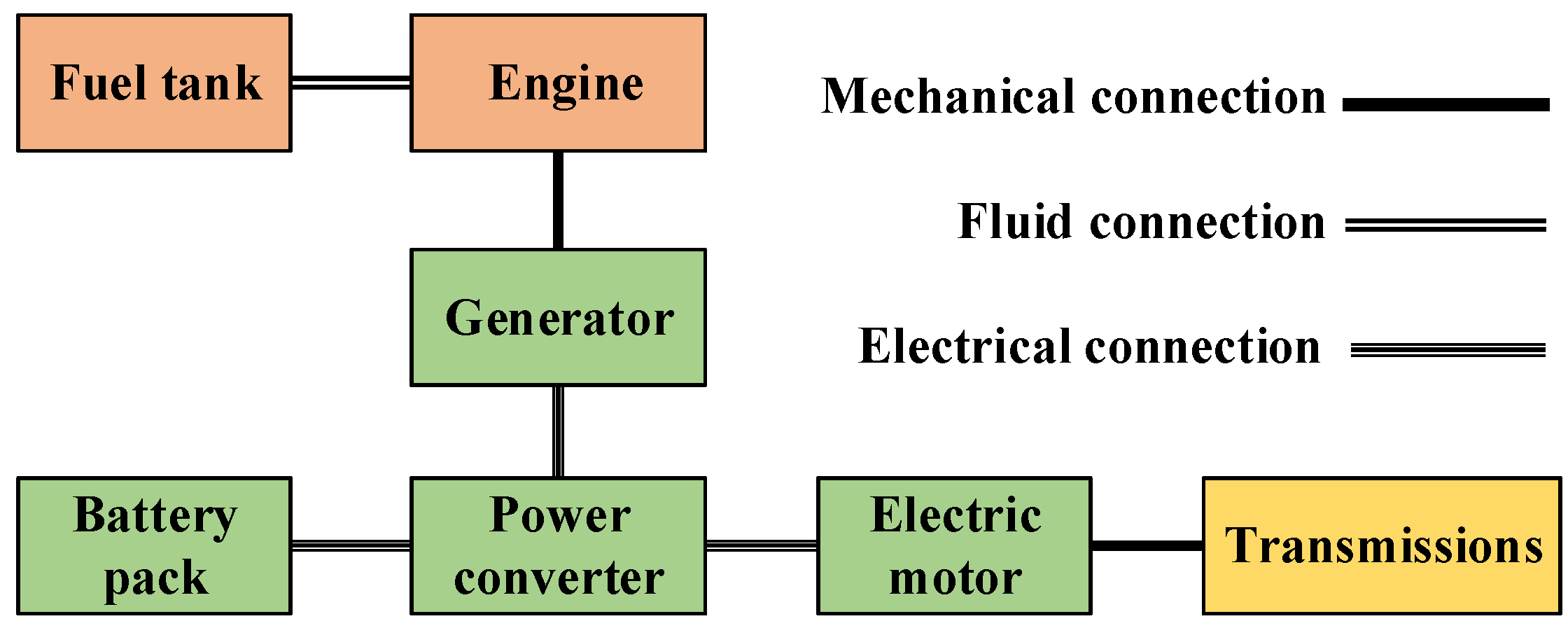
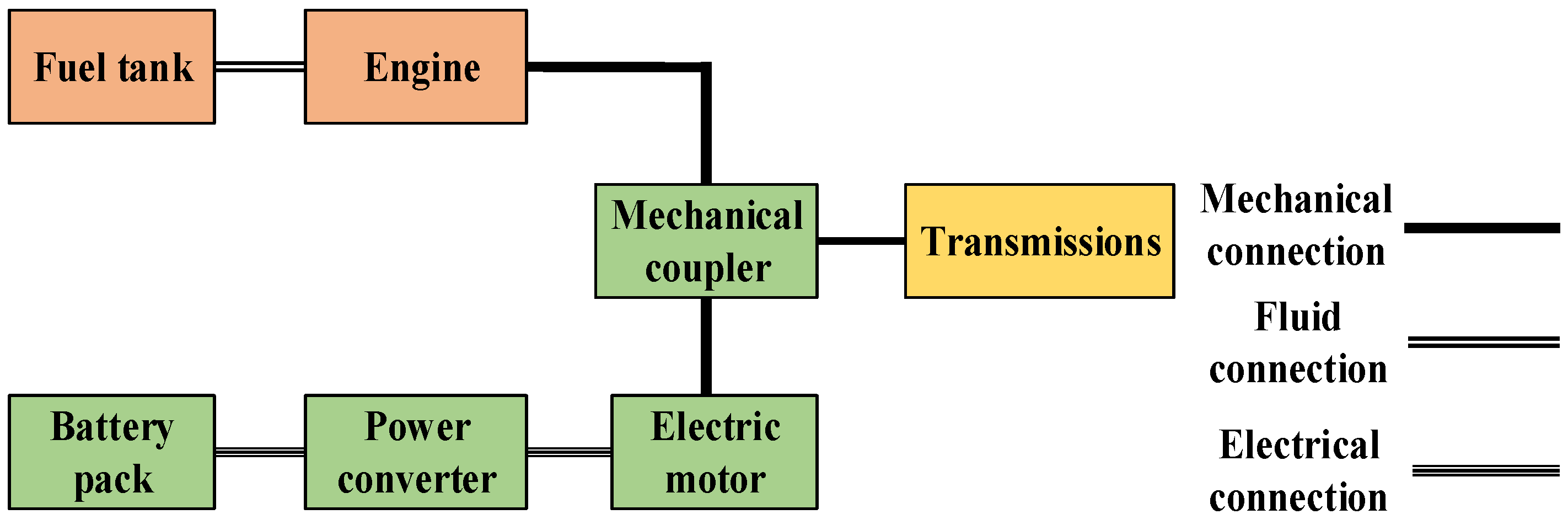



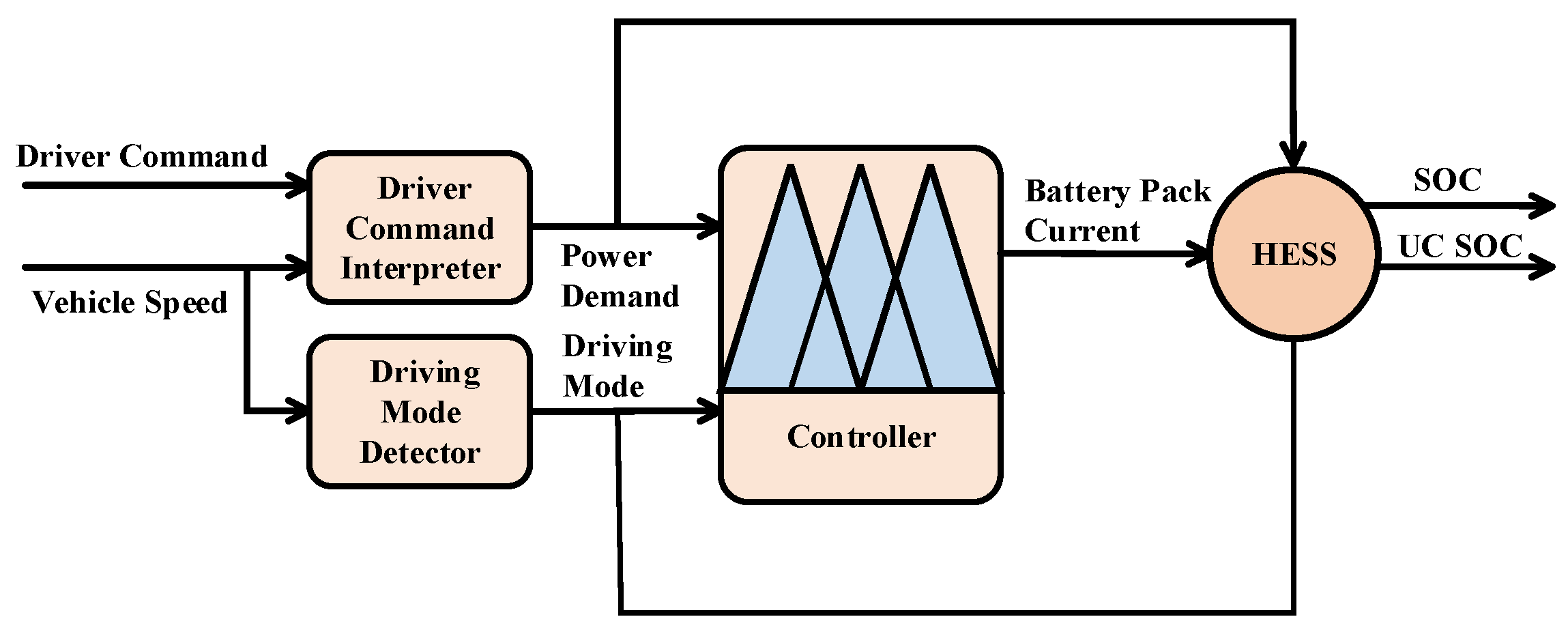
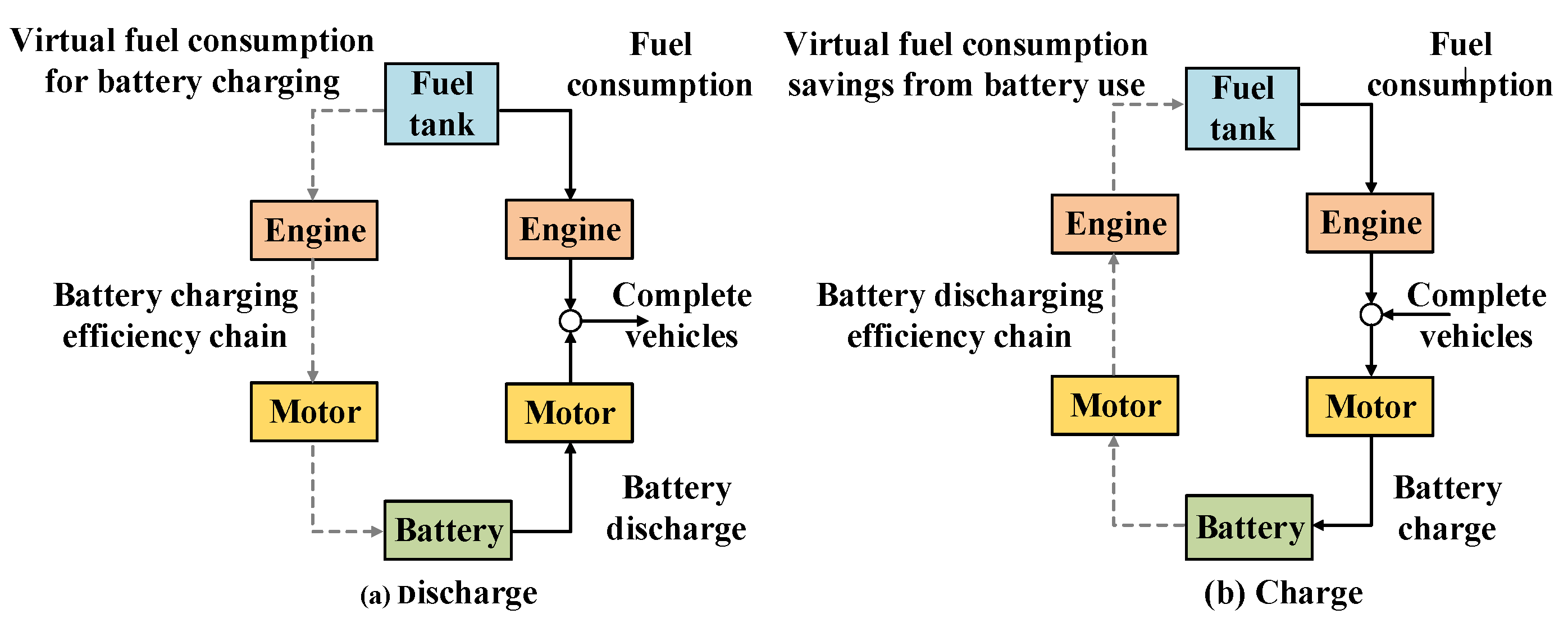
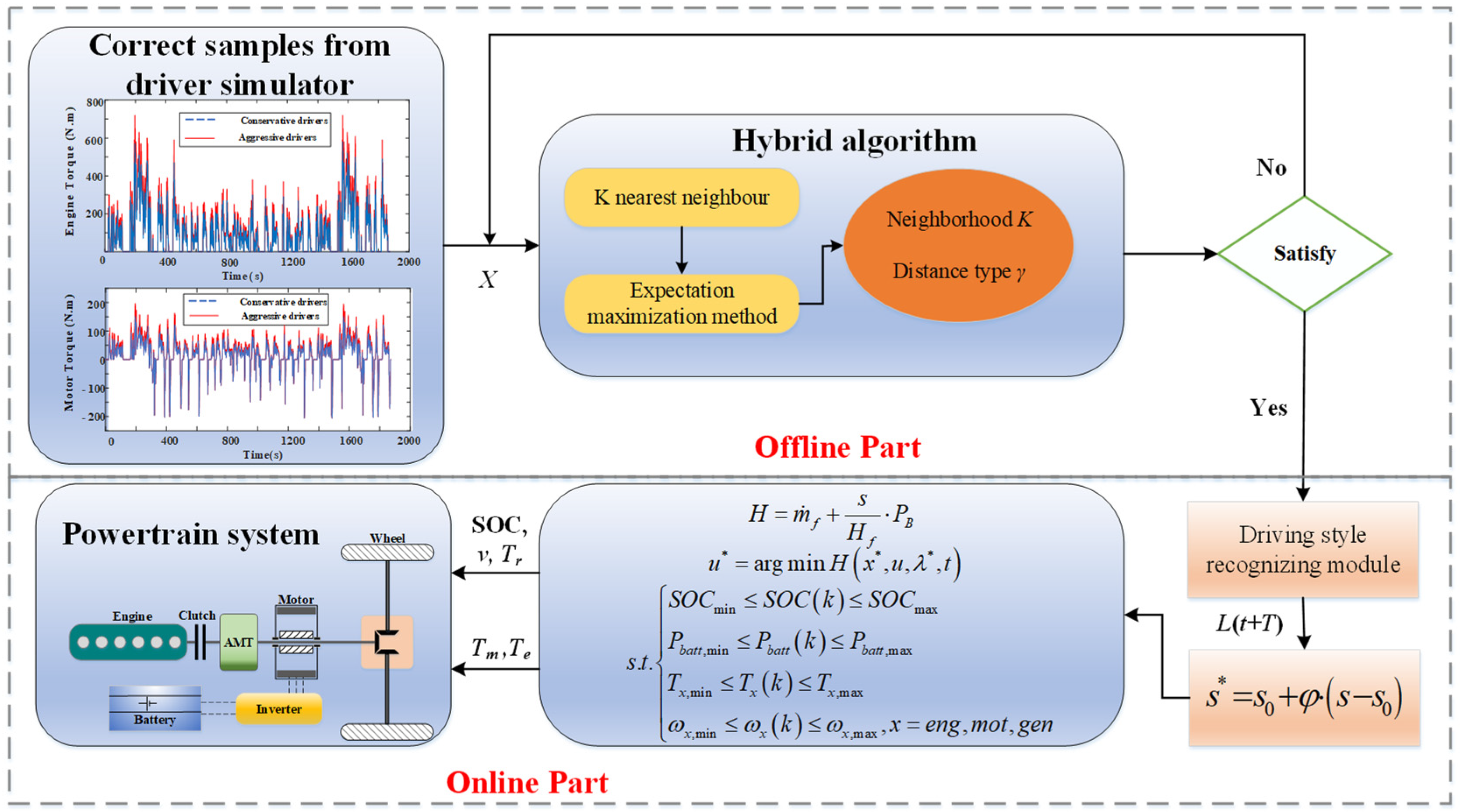
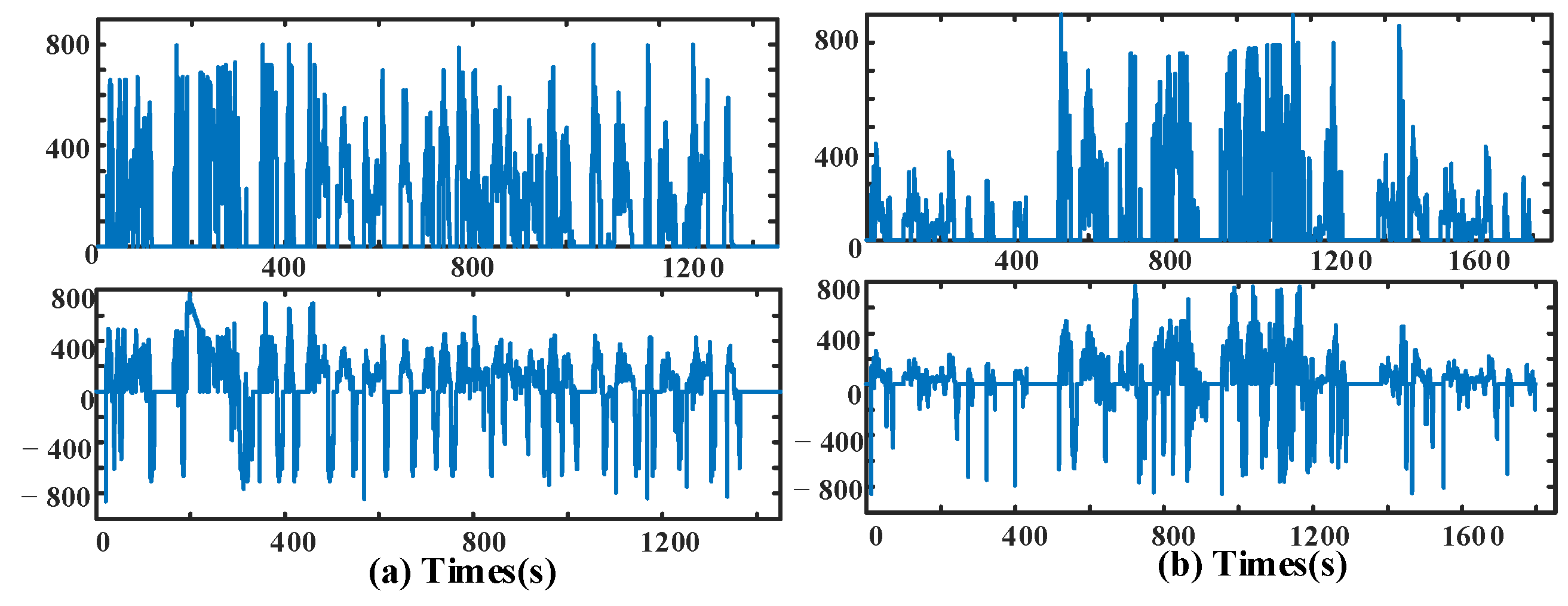
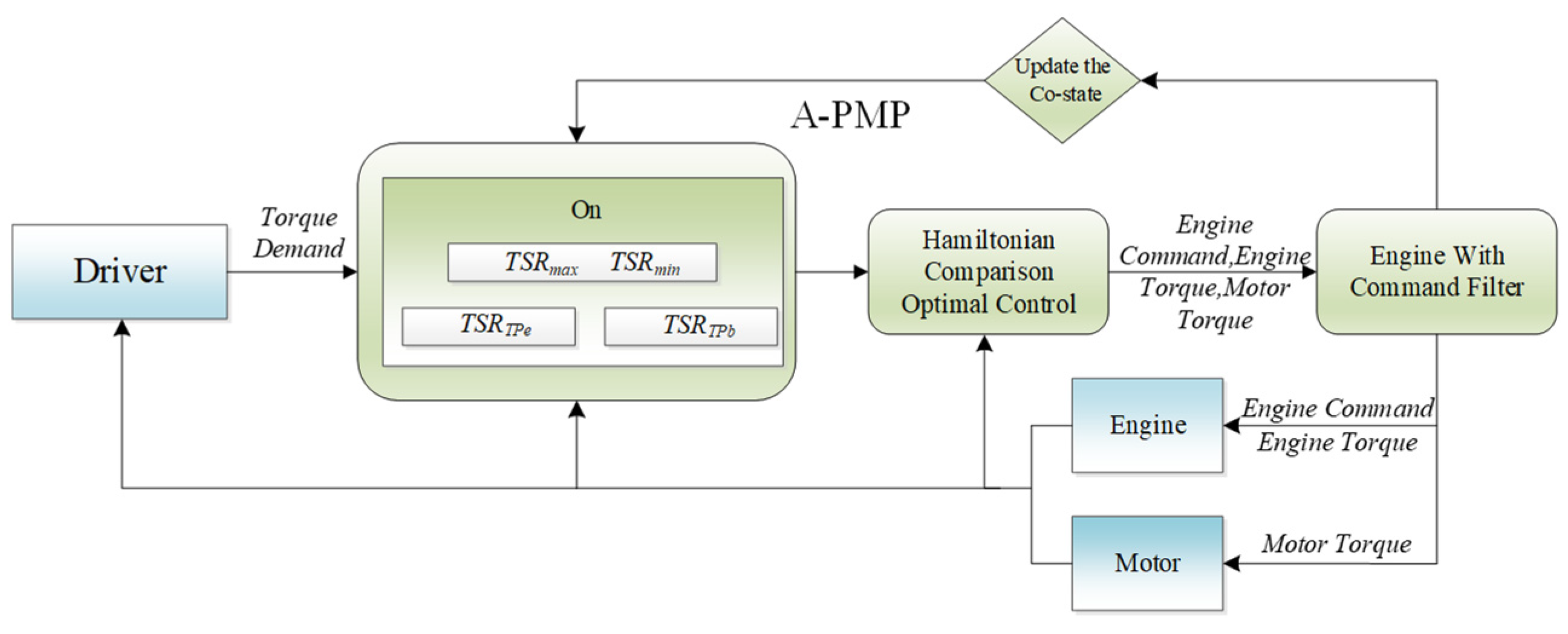


| Configuration | References | Advantages | Disadvantages |
|---|---|---|---|
| Series hybrid electric vehicle | [29,30,31,32,39,40] | Simple structure; Optimization is relatively simple | High number of energy conversions; Not energy efficient |
| Parallel hybrid electric vehicle | [33,34,35,36,41] | High energy efficiency; Rational torque distribution | Complex control strategies; Large control difficulty |
| Series–parallel hybrid electric vehicle | [37,38,42] | Multiple working modes; High energy efficiency | Complicated arrangement structure; High computational costs |
| Strategy | Initial SOC | Final SOC | Used Fuel Energy (108 J) | Savings (%) |
|---|---|---|---|---|
| Rule-based | 0.8 | 0.2893 | 2.2730 | - |
| DP | 0.8 | 0.3339 | 2.0146 | 11.37% |
| DOIP | 0.8 | 0.3093 | 2.0644 | 9.18% |
| Rule-based | 0.2 | 0.2893 | 3.0951 | - |
| DP | 0.2 | 0.3891 | 2.6383 | 14.76% |
| DOIP | 0.2 | 0.3348 | 2.7300 | 11.80% |
| ECMS | Adaptive ECMS | |||||
|---|---|---|---|---|---|---|
| Type | 1 | 2 | 3 | 1 | 2 | 3 |
| Fuel (L/100 km) | 10.56 | 9.39 | 8.95 | 9.42 | 8.66 | 8.52 |
| ∆Fuel (%) | −10.76 | −7.79 | −4.78 | |||
| Configuration | AE-CS | A-PMP | PMP |
|---|---|---|---|
| Fuel consumption (L/100 km) | 1.1333 | 1.0577 | 1.0618 |
| Final SOC | 0.3038 | 0.3043 | 0.3050 |
| Corrected fuel consumption (L/100 km) | 1.1333 | 1.0544 | 1.0538 |
| Corrected final SOC | 0.3038 | 0.3038 | 0.3038 |
| Fuel saving rate (%) | 0 | 6.96 | 7.01 |
| Time step (s) | 0.1 | 0.1 | 0.1 |
| Process time for the whole simulation | 2 min | 4 min | 6 h |
| Real time capability | Yes | Yes | Hardly |
| Strategy | References | Advantages | Disadvantages |
|---|---|---|---|
| Rule-based | [56,61,64,172,173] | Low technical difficulty of the method; low online calculation volume; wide industrial application. | Difficult to ensure charge maintenance; requires extensive tuning; poor robustness. |
| ECMS, PMP | [105,116,132,174,175,176,177,178,179] | Little calculation; no need for full working conditions information; good fuel economy. | No guarantee of global optimality; high impact of equivalence factors |
| MPC | [137,144,180,181] | Combining real-time and optimality; a wide range of applications. | Computationally intensive; over-simplified model |
| DP | [149,155,182,183,184] | Obtains the global optimal solution; performs directly multi-objective optimization. | Requires a high amount of computational power; no real-time optimization possible |
| Learning-based | [163,185,186,187,188] | Excellent adaptability and robustness; suitable for high non-linearity. | Complex calculations and low maturity. |
Disclaimer/Publisher’s Note: The statements, opinions and data contained in all publications are solely those of the individual author(s) and contributor(s) and not of MDPI and/or the editor(s). MDPI and/or the editor(s) disclaim responsibility for any injury to people or property resulting from any ideas, methods, instructions or products referred to in the content. |
© 2023 by the authors. Licensee MDPI, Basel, Switzerland. This article is an open access article distributed under the terms and conditions of the Creative Commons Attribution (CC BY) license (https://creativecommons.org/licenses/by/4.0/).
Share and Cite
Cao, Y.; Yao, M.; Sun, X. An Overview of Modelling and Energy Management Strategies for Hybrid Electric Vehicles. Appl. Sci. 2023, 13, 5947. https://doi.org/10.3390/app13105947
Cao Y, Yao M, Sun X. An Overview of Modelling and Energy Management Strategies for Hybrid Electric Vehicles. Applied Sciences. 2023; 13(10):5947. https://doi.org/10.3390/app13105947
Chicago/Turabian StyleCao, Yunfei, Ming Yao, and Xiaodong Sun. 2023. "An Overview of Modelling and Energy Management Strategies for Hybrid Electric Vehicles" Applied Sciences 13, no. 10: 5947. https://doi.org/10.3390/app13105947
APA StyleCao, Y., Yao, M., & Sun, X. (2023). An Overview of Modelling and Energy Management Strategies for Hybrid Electric Vehicles. Applied Sciences, 13(10), 5947. https://doi.org/10.3390/app13105947







